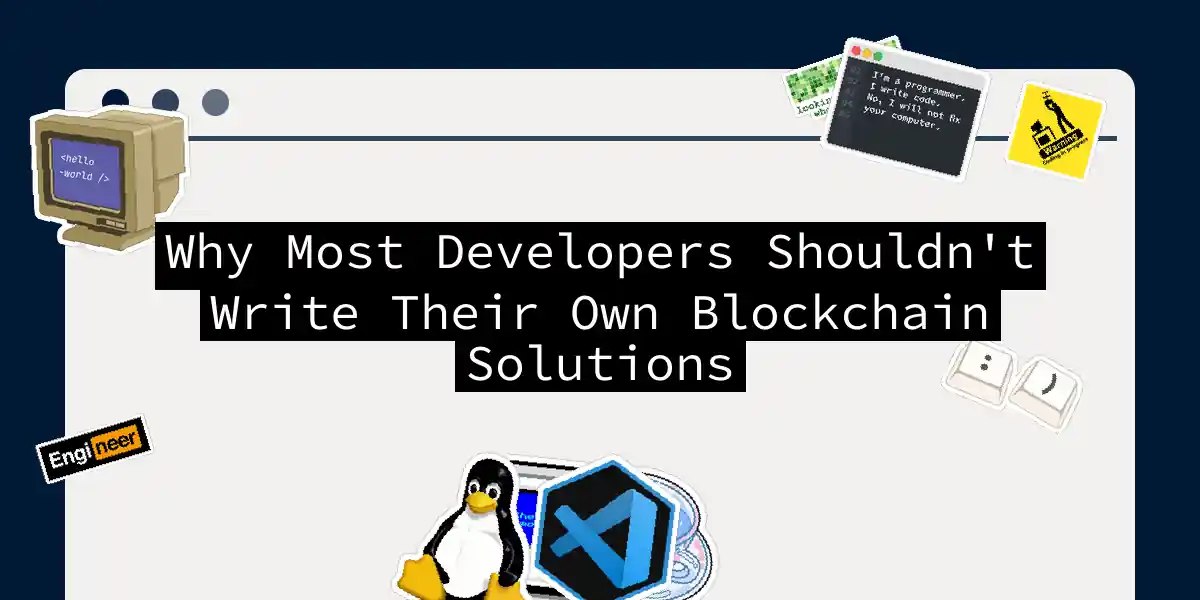When it comes to the allure of blockchain technology, it’s easy to get caught up in the hype. The promise of decentralized, secure, and transparent data management sounds like a dream come true for many developers. However, the reality is far more complex, and diving headfirst into building your own blockchain solution can be a recipe for disaster.
The Learning Curve: A Steep Climb
Transitioning from traditional software development to blockchain is not a trivial task. It requires a fundamental shift in mindset, from centralized to decentralized systems, which can be disorienting for beginners. The decentralized nature of blockchain demands a new way of thinking about data storage, security, and user interactions[1].
Imagine trying to learn a new language while simultaneously navigating a new city. You need to understand the grammar, vocabulary, and cultural nuances of the language, all while finding your way through unfamiliar streets. This is what it feels like to move from traditional development to blockchain.
Security: The Achilles’ Heel
Security is paramount in blockchain development. Unlike traditional apps, where security is often an afterthought, blockchain projects require robust security measures from the outset. This includes encryption, multi-factor authentication, and secure coding practices to mitigate risks and ensure the integrity of the application[2].
However, security in blockchain is a double-edged sword. On one hand, the decentralized and transparent nature of blockchain can enhance security by making it harder for a single entity to manipulate the data. On the other hand, the public accessibility of the blockchain can expose vulnerabilities and attract malicious actors.
Here’s a simple sequence diagram to illustrate the complexity of securing a blockchain transaction:
Scalability: The Elephant in the Room
Scalability is one of the most significant challenges facing blockchain technology. Unlike centralized databases that can handle thousands of transactions per second, many blockchain networks struggle to process even a fraction of that volume. This results in delays and poor performance, making blockchain less viable for high-transaction applications[4].
To put it into perspective, imagine a highway designed for 100 cars per hour but suddenly having to handle 10,000 cars. The congestion would be catastrophic. Similarly, blockchain networks need to be designed with scalability in mind from the very beginning.
Energy Consumption: The Environmental Impact
The energy consumption of blockchain networks, particularly those using Proof of Work (PoW) consensus mechanisms, is staggering. The process of solving complex mathematical puzzles to validate transactions requires powerful hardware that guzzles electricity. This has led to significant environmental concerns and has prompted some networks, like Ethereum, to transition to more energy-efficient consensus mechanisms like Proof of Stake (PoS)[5].
Here’s a flowchart to illustrate the decision-making process around choosing a consensus mechanism:
Regulatory Uncertainty: Navigating the Legal Maze
Blockchain development is not just about coding; it also involves navigating a complex regulatory landscape. Different countries have varying laws and regulations regarding blockchain and cryptocurrency, which can create uncertainty and legal risks for developers. For instance, the EU’s MiCA regulation provides a clear framework, but the U.S. regulatory environment is more fragmented, making compliance a significant challenge[5].
Imagine trying to build a house without knowing the local building codes. You might end up with a beautiful structure that is completely illegal. Similarly, blockchain developers need to be aware of and comply with the regulatory requirements in their jurisdiction.
User Experience: The Human Factor
Blockchain interfaces are often complex and user-unfriendly, which can deter mainstream adoption. Simplifying wallet designs, streamlining onboarding processes, and creating user-friendly decentralized applications (dApps) are crucial for making blockchain technology accessible to a broader audience[5].
Here’s a state diagram to illustrate the user onboarding process:
Conclusion: When to Seek Help
While it’s tempting to dive into blockchain development, the challenges outlined above make it clear that this is not a journey for the faint of heart. Here are a few scenarios where seeking help might be the best option:
- Lack of Experience: If you’re new to blockchain, it’s wise to start with existing solutions or seek guidance from experienced developers.
- Complex Requirements: If your project involves complex data processing, high scalability needs, or stringent security requirements, it might be better to leverage established blockchain platforms.
- Regulatory Compliance: Navigating the regulatory landscape can be daunting. Working with experts who are familiar with the legal aspects can save you a lot of trouble.
In conclusion, while blockchain technology holds immense promise, it is not a DIY project for most developers. The complexities involved in security, scalability, energy consumption, regulatory compliance, and user experience make it a domain best left to experts.
So, the next time you’re tempted to build your own blockchain solution, remember: sometimes it’s better to let the pros handle it. After all, you wouldn’t try to build a spaceship in your backyard, would you?
